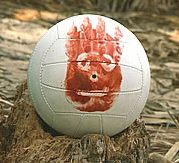Inspiration from Postsecret.com
Without the supporting characters, the main character in your story is just wandering around alone talking to him/herself. Even in a movie like Cast Away, where Tom Hanks is stranded on a deserted island for almost the entire movie, there are supporting characters that make him more relateable and further the plot (namely Wilson).
He's more than a little creepy.
So, when I'm trying to figure out my characters, I go speed dating.
1. Main Character (1)
2. Major Characters (3-5)
3. Minor Characters (3-10)
4. Two-Sceners (2-3)
5. Everyone else mentioned by name
Wait, what? Speed dating? Yes, speed dating. I use the categories above and work from the bottom up. Check it:
5. Everyone mentioned by name gets a brief, one-sentence summary of motivation and relevance to the story. Like the first few crummy dates at a speed dating table (or what I assume they're like). "Yeesh, get me out of here."
4. Two-Sceners are the characters that appear in only one or two scenes but are still important to the whole story (i.e. the sympathetic cop who gives the hardened criminal a break that gives the criminal the opportunity to do x or z). They get 2 sentences. "You're kind of interesting, but I'm still not into you."
3. Minor characters are usually a part of a major event in the story or are in the story for a significant period of time. They tend to be more in the background, but still interact with the MC enough that they're not just Two-Sceners. They get a whole paragraph about motivation, significant personality traits, and relevance to the story.
2. Major characters are the buddies. The best friend of the MC, the enemy of the MC, the guy who follows the MC around the entire book until he just becomes useful. These are the characters that can make or break a story. As a result, they get 3-5 paragraphs on personality, appearance, motivation, brief background (usually not included in the story but helpful to the author), and anything else that seems important.
1. MC - obviously take all of the time in the world for this guy/girl.
Everyone has a different process, this is just the way I get to know my characters. The main point is to not forget them. The supporting characters in someone's life story are the ones that help to move the life story along or change the life for better or for worse. They make a huge impact on the story either way so please, no cardboard friends.
How do you get to know your supporting characters?
How do you get to know your supporting characters?


No comments:
Post a Comment